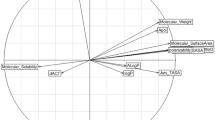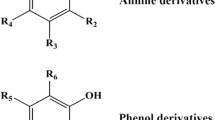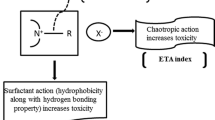Abstract
To limit in vivo experiments, the use of quantitative structure-activity relationships (QSARs) is advocated by REACH regulation to predict the required fish, invertebrate, and algae EC50 for chemical registration. The aim of this work was to develop reliable QSARs in order to model both invertebrate and algae EC50 for organic solvents, regardless of the mechanism of toxic action involved. EC50 represents the concentration producing the 50 % immobilization of invertebrates or the 50 % growth inhibition of algae. The dataset was composed of 122 organic solvents chemically heterogeneous which were characterized by their invertebrate and/or algae EC50. These solvents were described by physico-chemical descriptors and quantum theoretical parameters calculated via density functional theory. QSAR models were developed by multiple linear regression using the ordinary least squares method and descriptor selection was performed by the Kubinyi function. Invertebrate EC50 was well-described with LogP, dielectric constant, surface tension, and minimal atomic Mulliken charges while algae EC50 of organic solvents (except amines) was predicted with LogP and LUMO energy. To evaluate robustness and predictive performance of the QSARs developed, several strategies have been used to select solvent training sets (random, EC50-based selection and a space-filling design) and both internal and external validations were performed.





Similar content being viewed by others
References
Regulation No 1907/2006 of the European Parliament and of the Council of 18 December 2006 concerning the Registration, Evaluation, Authorization and Restriction of Chemicals (REACH). Official J. of the European Union, L396/1-849, European Commission, Brussels, Belgium
Technical Guidance Document (TGD) on the Risk Assessment in support of the Commission directive 93/67/EEC on Risk Assessment for New Notified Substances, the Commission Regulation No 1488/94 on risk Assessment for Existing Substances and the Directive 98/8/EC concerning the placing of biocidal products on the market. Institute for health and consumer protection, European chemicals Bureau, Luxembourg
Working document. Guidance Document on Aquatic Ecotoxicology in the context of the Directive 91/414/ECC. European Commission, Health & Consumer protection directorate-generale
Katritzky AR, Lobanov VS, Karelson M (1995) QSPR: the correlation and quantitative prediction of chemical and physical properties from structure. Chem Soc Rev 24:279–287
Tropsha A (2010) Best practices for QSAR model development, validation, and exploitation. Mol Inf 29:476–488
Konemann H (1981) Quantitative structure-activity relationships in fish toxicity studies. Part 1: relationship for 5 industrial pollutants. Toxicology 19:209–221
Mazzatorta P, Vračko M, Jezierska A, Benfenati E (2003) Modeling toxicity by using supervised Kohonen neural networks. J Chem Inf Comput Sci 43:485–492
Katritzky AR, Slavovn SH, Stoyanova-Slavova S, Kahn I, Karelson M (2009) Quantitative structure-activity relationships (QSAR) modeling of EC50 of aquatic toxicities for Daphnia magna. J Toxicol Environ Health Part A 72:1181–1190
Toropova AP, Toropov AA, Benfenati E, Gini G (2012) QSAR models for toxicity of organic substances to Daphnia magna built up by using the CORAL Freeware. Chem Biol Drug Des 79:332–338
Hsieh SH, Hsu CH, Tsai DY, Chen CY (2006) Quantitative structure-activity relationships for toxicity of nonpolar narcotic chemicals to Pseudokirchneriella subcapitata. Environ Toxicol Chem 25:2920–2926
Lu G, Wang C, Tang Z, Guo X (2007) Joint toxicity of aromatic compounds to algae and QSAR study. Ecotoxicology 16:485–490
Kar S, Roy K (2010) QSAR modeling of toxicity of diverse organic chemicals to Daphnia magna using 2D and 3D descriptors. J Hazard Mater 177:834–840
Lee PY, Chen CY (2009) Toxicity and quantitative structure-activity relationships of benzoic acids to Pseudokirchneriella sucapitata. J Hazard Mater 165:156–161
Faucon JC, Bureau R, Faisant J, Briens F, Rault S (2001) Prediction of the Daphnia acute toxicity from heterogeneous data. Chemosphere 44:407–422
Moosus M, Maran U (2011) Quantitative structure-activity relationships analysis of acute toxicity of diverse chemicals to Daphnia magna with whole molecule descriptors. SAR QSAR Environ Res 22:57–774
Kamaya Y, Fukaya Y, Suzuki K (2005) Acute toxicity of benzoic acids to the crustacean Daphnia magna. Chemosphere 59:255–261
Chen CY, Kuo KL, Fan JW (2012) Toxicity of propargylic alcohols on green alga Pseudokirchneriella subcapitata. J Mol Struct 14:181–186
Zeng M, Lin Z, Yin D, Zhang Y, Kong D (2011) A K(ow)-based QSAR model for predicting toxicity of halogenated benzenes to all algae regardless of species. Bull Environ Contam Toxicol 86:565–570
Passino-Reader DR, Hickey JP, Ogilvie LM (1997) Toxicity to Daphnia pulex and QSAR predictions for polycyclic hydrocarbons representative of Great Lake contaminants. Bull Environ Contam Toxicol 59:834–840
Lee YG, Hwang SH, Kim SD (2006) Predicting the toxicity of substituted phenols to aquatic species and its changes in the stream and effluent waters. Arch Environ Contam Toxicol 50:213–219
Lessigiarska I, Worth AP, Sohull-Klüttgen B, Jeram S, Dearden JC, Netzeva TI, Cronin MTP (2004) QSAR investigation of a large data set for fish, algae, and daphnia toxicity. SAR QSAR Environ Res 15:413–431
Voutchkova VM, Kostal J, Steinfeld JB, Emerson JW, Brooks BW, Anastas P, Zimmerman JB (2011) Towards rational molecular design: derivation of property guidelines for reduced acute aquatic toxicity. Green Chem 13:2373–2379
Niculescu SP, Lewis MA, Tigner J (2008) Probabilistic neural networks modeling of the 48-h LC50 acute toxicity endpoint to Daphnia magna. SAR QSAR Environ Res 19:735–750
Tao S, Xiaohuan X, Fuliu X, Bengang L, Cao J, Dawson R (2002) A fragment constant QSAR model for evaluating the EC50 values of organic chemicals to Daphnia magna. Environ Sci Technol 45:4616–4622
Toropova AP, Toropov AA, Martyanov SE, Benfenati E, Gini G, Leszczynska D, Leszczynska J (2012) CORAL: QSAR modeling of toxicity of organic chemicals toward Daphnia magna. Intell Lab Syst 110:177–181
Levet A, Bordes C, Clément Y, Mignon P, Chermette H, Marote P, Cren-Olivé C, Lantéri P (2013) Quantitative structure-activity relationship to predict acute fish toxicity of organic solvents. Chemosphere 93:1094–1103
Chastrette M, Rajzmann M, Chanon M, Purcell KF (1985) Approach to a general classification of solvents using a multivariate statistical treatment of quantification solvent parameters. J Am Chem Soc 107:1–11
Durand M, Molinier V, Kunz W, Aubry JM (2011) Classification of organic solvents revisited by using the COSMO-RS approach. Chem Eur J 17:5155–5164
Cheremisinoff NP (2003) Industrial solvents handbooks, second edn. CRC, Boca Raton
Smallwood I (1996) Handbook of organic solvent properties. Arnold
Yalkowxky SH, He Y, Jain P (2010) Handbook of aqueous solubility data, second edn. CRC, Boca Raton
Yaws CL (1999) Chemical properties handbook. McGraw-Hill, New York
Weast RC (1975) Handbooks of chemistry and physics, 56th edn. CRC, Boca Raton
Perdew JP, Burke K, Ernzerhof M (1996) Generalized gradient approximation made simple. Phys Rev Lett 77:3865–3868
Wiener H (1947) Structural determination of paraffin boiling points. J Am Chem Soc 69:17–20
Balaban AT (1982) Highly discriminating distance-based topological index. Chem Phys Lett 89:399–404
Randić M (1975) On characterizaztion of molecular branching. J Am Chem Soc 97:6609–6611
Kier LB (1989) An index of molecular flexibility from kappa shape attributes. Quant Struct –Act Relat 8:221–224
Mercader AG, Duchowicz PR, Fernandez FM, Castro EA (2008) Modified and enhanced replacement method for the selection of molecular descriptors in QSAR and QSPR theories. Chemom Intell Lab Syst 92:138–144
Kubinyi H (1994) Variable selection in QSAR studies. I. An evolutionary algorithm. Quant Struct-Act Relat 13:285–294
Johnson ME, Moore LM, Ylvisaker D (1990) Minimax and maximim distance designs. J Stat Plan Int 26:131–148
Chirico N, Gramatica P (2011) Real external predictivity of QSAR models: how to evaluate it? Comparison of different validation criteria and proposal of using the concordance correlation coefficient. J Chem Inf Model 51:2320–2335
Chirico N, Gramatica P (2012) Real External Predictivity of QSAR Models. Part 2. New Intercomparable Thresholds for Different Validation Criteria and the Need for Scatter Plot Inspection. J Chem Inf Model 52:2044–2058
Shi LM, Fang H, Tong W, Wu J, Perkins R, Blair RM, Branham WS, Dial SL, Moland CL, Sheehan DM (2001) QSAR models using a large diverse set of estrogens. J Chem Inf Comput Sci 41:186–195
Schüürmann G, Ebert RU, Chen J, Wang B, Kühne R (2008) External validation and prediction employing the predictive squared correlation coefficient—Test set activity mean vs training set activity mean. J Chem Inf Model 48:2140–2145
Consonni V, Ballabio D, Todeschini R (2009) Comments on the definition of the Q2 parameter for QSAR Validation. J Chem Inf Model 49:1669–1678
Consonni V, Ballabio D, Todeschini R (2010) Evaluation of model predicitive ability by external validation techniques. J Chemometrics 24:194–201
Roy PP, Paul S, Mitra I, Roy K (2009) On-two novel parameters for validation of predictive QSAR models. Molecules 14:1660–1701
Roy K, Mitra I, Kar S, Ojha PK, Das RN, Kabir H (2012) Comparative studies on some metrics for external validation of QSPR models. J Chem Inf Model 52:396–408
Golbraikh A, Tropsha A (2002) Beware of q2! J Mol Graph Model 20:269–276
Lin LI (1989) A concordance correlation coefficient to evaluate reproducibility. Biometrics 45:255–268
OECD (2007) Series on testing and assessment. Number 69. Guidance document on the validation of (quantitative) structure-activity relationship [(Q)SAR] models
OECD (2004) Series on testing and assessment. Number 49. The report from the expert group on QSARs on the principles for the validation of QSARs
Eriksson L, Jaworska J, Worth AP, Cronin MTD, McDowell RM, Gramatica P (2003) Methods for reliability and uncertainty assessment and for Applicability evaluations of classification- and regression-based QSARs. Environ Health Perspect 111:1361–1375
Gramatica P (2007) Principles of QSAR models validation: internal and external. QSAR Comb Sci 26:694–701
Voutchkova AM, Osimitz TG, Anastas PT (2010) Toward a comprehensive molecular design framework for reduced hazard. Chem Rev 110:5845–5882
Cronin MTD, Walker JD, Jaworska JS, Comber MHI, Watts CD, Worth AP (2003) Use of QSARs in international decision-making frameworks to predict ecologic effects and environmental fate of chemical substances. Environ Health Perspect 111:1376–1390
Reuschenbach P, Silvani M, Dammann M, Warnecke D, Knacker T (2008) ECOSAR model performance with a large test set of industrial chemicals. Chemosphere 71:1986–1995
Tunkel J, Mayo K, Austin C, Hickerson A, Howard P (2005) Practical considerations on the use of predictive models for regulatory purposes. Environ Sci Technol 39:2188–2199
Parkerton TF, Konkel WJ (2000) Application of quantitative structure-activity relationships for assessing the aquatic toxicity of phthalate esters. Ecotoxicol Environ Saf 45:61–78
Hodges G, Roberts DW, Marshall SJ, Dearden JC (2006) The aquatic toxicity of anionic surfactants to Daphnia magna—a comparative QSAR study of linear alkylbenzene sulphonates and ester sulphonates. Chemosphere 63:1443–1450
Buth JM, Arnold WA, McNeill K (2007) Unexpected products and reaction mechanisms of the aqueous chlorination of cimetidine. Environ Sci Technol 41:6228–6233
Tremolada P, Finizio A, Villa S, Gaggi C, Vighi M (2004) Quantitative inter-specific chemical activity relationships of pesticides in the aquatic environment. Aquat Toxicol 67:87–103
Zhang XJ, Qin HW, Su LM, Qin WC, Zou MY, Sheng LX, Zhao YH, Abraham MH (2010) Interspecies correlations of toxicity to eight aquatic organisms: theoretical considerations. Sci Total Environ 408:4549–4555
Netzeva TI, Aptula AO, Benfenati E, Cronin MTD, Gini G, Lessaigiarska I, Maran U, Vračko M, Schüürmann G (2005) Description of the electronic structure of organic chemicals using semiempirical and ab initio methods for development of toxicological QSARs. J Chem Inf Model 45:106–114
Henegar A, Mombelli E, Pandard P, Péry ARR (2011) What can be learnt from an ecotoxicity database in the framework of the REACh regulation? Sci Total Environ 409:489–494
Tebby C, Mombelli E, Pandard P, Péry ARR (2011) Exploring an ecotoxicity database with the OCDE (Q)SAR Toolbox and DRAGON descriptors in order to priorise testing on algae, daphids and fish. Sci Total Environ 409:3334–3343
Christensen AM, Faaborg-Andersen S, Ingerslev F, Baun A (2007) Mixture and single- substance toxicity of selective serotonin reuptake inhibitors toward algae and crustaceans. Environ Toxicol Chem 26:85–91
Escher BI, Bramaz N, Richter I, Lienert J (2006) Comparative ecotoxicological hazard assessment of Beta-flockers and their human metabolites using a mode-of-action based test battery and a QSAR approach. Environ Sci Technol 40:7402–7408
Von der Ohe PC, Kühne R, Ebert R-U, Alterburger R, Liess M, Schüürmann G (2005) Structural alerts- a new classification model to discriminate excess toxicity from narcotic effect levels of organic compounds in the acute daphnids assay. Chem Res Toxicol 18:535–555
Papa E, Villa F, Gramatica P (2005) Statistically validated QSARs, based on theoretical descriptors, for modeling aquatic toxicity of organic chemicals in Pimephales promelas (fathead minnow). J Chem Inf Model 45:1256–1566
Neuwoehner J, Escher BI (2011) The pH-dependent toxicity of basic pharmaceuticals in the green algae Scendesmus vacuolatus can be explained with a toxicokinetic ion- trapping model. Aquat Toxicol 101:266–275
Huang CP, Wang Y-J, Chen C-Y (2007) Toxicity and quantitative structure activity relationships of nitriles based on Pseudokirchneriella sucapitata. Ecotoxicol Environ Saf 67:439–446
Lu G-H, Yuan X, Zhao Y-H (2001) QSAR study on the toxicity of substituted benzenes to the algae (Scenedesmus obliquus). Chemosphere 44:437–440
Schmitt H, Alterburger R, Jastorff B, Schüürmann G (2000) Quantitative Structure-activity analysis of the algae toxicity of nitroaromatic compounds. Chem Res Toxicol 13:441–450
Zhu M, Ge F, Zhu R, Wang X, Zheng X (2010) A DFT based QSAR study of the toxicity of quaternary ammonimum compounds on Chlorella vulgaris. Chemosphere 80:46–52
Acknowledgments
This study was supported by the National Research Agency (ANR) within the project NESOREACH. The authors also gratefully acknowledge L. Geoffroy, L. Chancerelle and P. Pandard from the INERIS Institut.
Author information
Authors and Affiliations
Corresponding author
Additional information
This paper belongs to Topical Collection Festschrift in Honor of Henry Chermette
Electronic supplementary material
Below is the link to the electronic supplementary material.
ESM 1
(DOCX 25.8 kb)
Rights and permissions
About this article
Cite this article
Levet, A., Bordes, C., Clément, Y. et al. Acute aquatic toxicity of organic solvents modeled by QSARs. J Mol Model 22, 288 (2016). https://doi.org/10.1007/s00894-016-3156-0
Received:
Accepted:
Published:
DOI: https://doi.org/10.1007/s00894-016-3156-0




